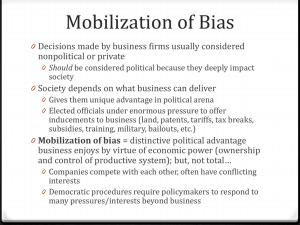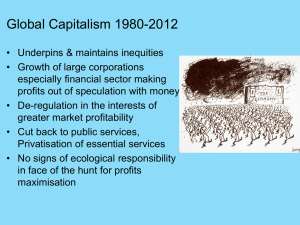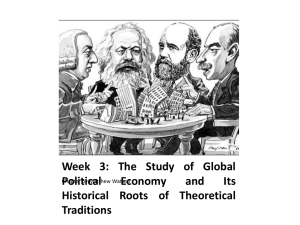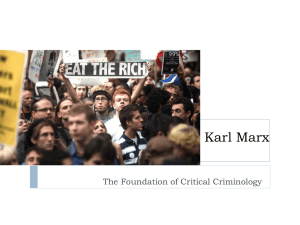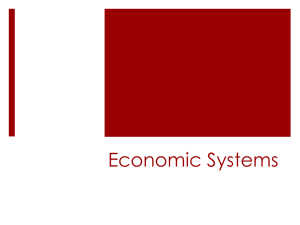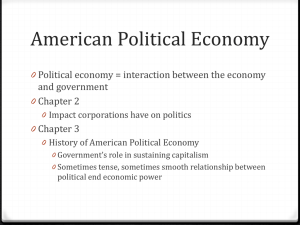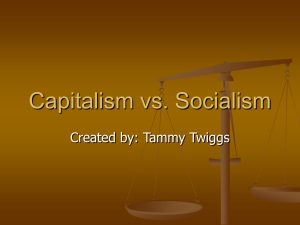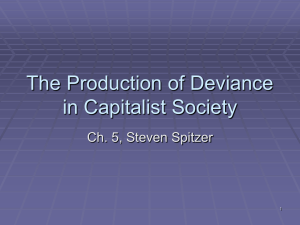The Social Economy
advertisement
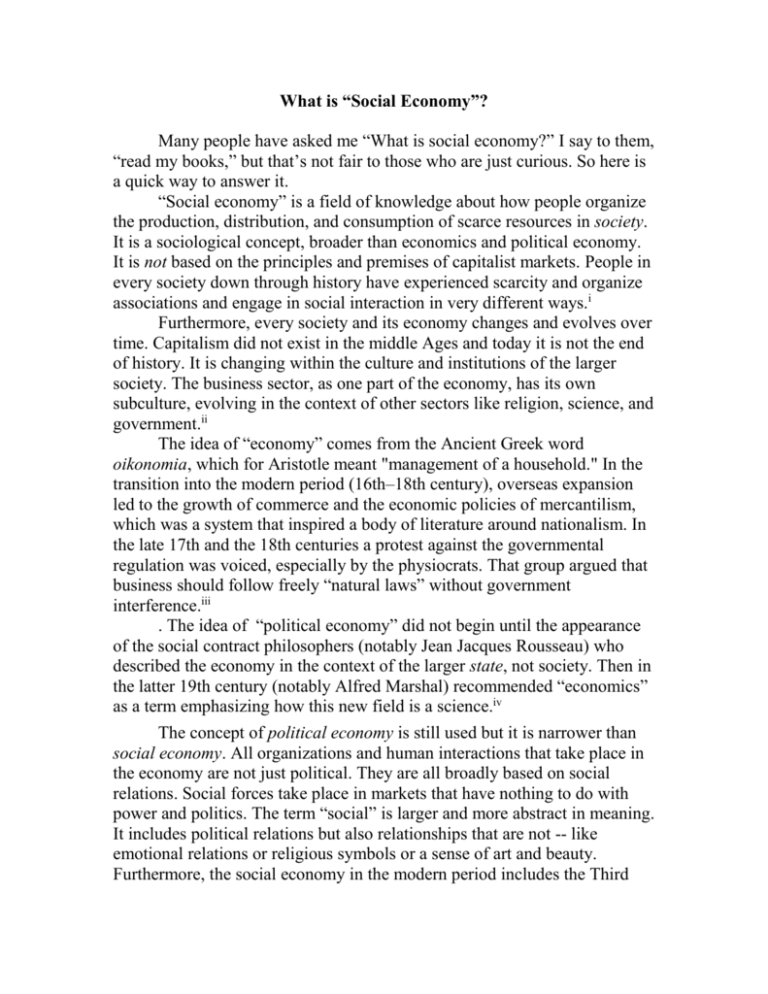
What is “Social Economy”? Many people have asked me “What is social economy?” I say to them, “read my books,” but that’s not fair to those who are just curious. So here is a quick way to answer it. “Social economy” is a field of knowledge about how people organize the production, distribution, and consumption of scarce resources in society. It is a sociological concept, broader than economics and political economy. It is not based on the principles and premises of capitalist markets. People in every society down through history have experienced scarcity and organize associations and engage in social interaction in very different ways.i Furthermore, every society and its economy changes and evolves over time. Capitalism did not exist in the middle Ages and today it is not the end of history. It is changing within the culture and institutions of the larger society. The business sector, as one part of the economy, has its own subculture, evolving in the context of other sectors like religion, science, and government.ii The idea of “economy” comes from the Ancient Greek word oikonomia, which for Aristotle meant "management of a household." In the transition into the modern period (16th–18th century), overseas expansion led to the growth of commerce and the economic policies of mercantilism, which was a system that inspired a body of literature around nationalism. In the late 17th and the 18th centuries a protest against the governmental regulation was voiced, especially by the physiocrats. That group argued that business should follow freely “natural laws” without government interference.iii . The idea of “political economy” did not begin until the appearance of the social contract philosophers (notably Jean Jacques Rousseau) who described the economy in the context of the larger state, not society. Then in the latter 19th century (notably Alfred Marshal) recommended “economics” as a term emphasizing how this new field is a science.iv The concept of political economy is still used but it is narrower than social economy. All organizations and human interactions that take place in the economy are not just political. They are all broadly based on social relations. Social forces take place in markets that have nothing to do with power and politics. The term “social” is larger and more abstract in meaning. It includes political relations but also relationships that are not -- like emotional relations or religious symbols or a sense of art and beauty. Furthermore, the social economy in the modern period includes the Third Sector with its churches, science associations and civic groups with their own cultures. In its broad sense, the social economy includes all income making organizations including the family and government.v Etymology The origin of such terms in history is relevant here. The words “social” and “economy” evolved with the concept of “society.” The word “society” did not exist in the time of the ancient Greeks. Aristotle did not write about the economy in society, rather, he wrote about the family and government. And economics was not a word in his vocabulary even though he talked about the use of goods in the marketplace.vi The words themselves, “social” and “society,” appeared at the time of the Social Contract philosophers in the sixteenth and seventeenth century. The word “society” was evolving variously to mean “A system of sharing within a group,” and the “condition of living or associating with others,” and “companionship, fellowship, or company,” as well as human association or friendly interaction with other people. It evolved to mean “the company of others, the system of customs and organization adopted by a group of people for harmonious coexistence or mutual benefit, an aggregate of persons living together in a community, esp. one having shared customs, laws, and institutions.” (See The Oxford Dictionary.) It was then defined in more complex terms by sociologists in the nineteenth and twentieth centuries. See the history of civil society as a concept in Appendix A and B of the Civil Republic posted on my webpage.vii Adam Smith did not know the word “capitalism”. It did not exist in the English language when he was writing in 1776. It came to be popular with Karl Marx’s Das Kapital in 1867.viii The Social Factor Capitalism for professionals came to be defined as an economic system based on private ownership of the means of production and the creation of goods and services for a profit. Competitive markets, wage labor, capital accumulation, voluntary exchange, and personal finance are part of markets considered capitalistic but this is not the whole story. The work of Karl Polanyi is important here because he saw how an economy is submerged in social relationships. Government policies for him were instrumental in helping to develop capitalist markets. His book on The Great Transformation is a history of the self-regulating market and its emergence from the Industrial Revolution. He wrote about the cultivation of the market economy through the efforts of statesmen of England in the first decades of the nineteenth century. The market was brought into existence by government not just by “natural” forces. He saw how social processes like cooperation, reciprocity, and association (not just competition) were central to the development of markets.ix People think today that the market is based primarily on competition and the bottom line is economic (money and profits) i.e. markets are driven by financial incentives. Many believe that there would be no incentive to work and that no inventions would take place without the goal of making money. They forget that inventions took place long before the appearance of capitalism. Inventions are part of nature.x Put another way, there is a social order that underlies every economic order. The bottom line is “social” in its analytical meaning, not “economic” in its scientific meaning with formulas and calculations on prices, or making money. The capitalist economy is based on human organization, not just profits. This perspective of the “economic order” based on a “social order” -alters the way we see it change in the context of society.xi Sociologists study the way a corporation is socially organized, and not all by command systems. (A corporation can be organized successfully on a system of “mutual governance” as well as on a system of “command bureaucracy”.) We can study how some corporations have decentralized their operations and developed self-management and worker ownership successfully in a market changing its character. Employee ownership is evolving now in business but it is not typical of capitalism. The way a market is socially organized can show how the capitalism is changing as well as predict a market sector’s success or failure. This is because there are many social processes by which a market system is organized, not just by competition. These processes include collaboration, accommodation, assistance, adjustment, support, conflict, tension, negotiation, absorption, integration, cooperation, assimilation and democratic processes, not just competition. Indeed corporations were competing so hard in the 19th century that they were destroying each other; hence, they decided to cooperate and created trade associations. Trade associations developed as a form of democratic governance with electoral processes based on their members.xii There are different theories that develop around markets. For example, there is the so-called “social market theory” and also “market socialism.” Proponents seek a middle path between socialism and laissezfaire economics. Theorists argue that government regulation is required to establish fair competition. They argue that governments can maintain a balance between a high rate of economic growth, low inflation and low levels of unemployment, good working conditions and social welfare -- by using state intervention. This has truth in it, factually and normatively, but it is not my theory. I claim that the purpose of a government is to cultivate a basis for the market economy to regulate itself. In this case, the state encourages market organizations that will help corporations govern themselves for the common good apart from the state. The purpose of government is to lessen its need to regulate the economy. In addition to other purposes like promoting the general welfare and protection of its citizens from outside invaders, the purpose of a state is increase the transparency and public accountability of markets. The goal of government is to lay the basis for self-governance in the private sector. This is different from positions taken by Democratic and Republic parties in the United States but in accord with their key values. Most Republicans and conservative economists claim that the market is already self-regulating. This is partially true but not enough to keep the market from being destructive to people and the environment. I view the current market organization as self-destructive in ways that require a parent state to regulate it. The capitalist economy is not truly self-regulating. It is like in an adolescence stage of evolution, not yet developed and mature enough to be independent of the government. Democrats and leftist economists claim that the government should regulate the market. This is true, normatively, but such policies alone lead toward bigger government. The capitalist market will find new ways to be exploitive in spite of government regulations.xiii Hence, the market requires the government to build a new organization to be truly free, profitable, self-regulating, self-correcting and self-reliant without government regulations.xiv Let’s look at modern history to see how states developed selfgovernance. In the 18th century we see state self-governance emerging by degree -- from feudalism to become a " democracy" with a representative assembly, and a judicial system. At the same time we see the business sector evolving as a private domain keeping the feudal tradition. In the United States, citizens were afraid of the new corporations and required state charters with ethical rules to operate. But states began to compete for charters and corporations went to those with the lowest social standards in their charters, mainly Delaware and New Jersey. By the end of the 19th century people described the market composed of the “lords and barons of industry.” The capitalist economy developed without the basic forms of democracy. Government regulations then began to take place to protect the public.xv My question is how the economy could become self-governing as a private sector so that it works for the common good apart from the state. How can the private sector become truly free and self-regulating? In 1776 Adam Smith wrote The Wealth of Nations in which he thought the new economy would work for the common good. He described how wealth is produced in a “self-regulating market.” The market was selfregulating for Smith because people produced according to what people would buy and people consumed according to what they wanted and could afford. Businesses in his day were new and small. Freedom to trade was part of this so-called self-regulating market -- a freedom depicted by Frenchmen as laissez faire. The great value in these innovative markets was “freedom from government controls.” Smith coined the phrase “invisible hand” to describe how individual ambition and self-interest benefits society even when such motives have no benevolent intention. Since Smith's time, the principle of the invisible hand has developed in economic theory but the fact is: nobody really understands how it happens. Well, it did happen by some measure but how it failed miserably is not explained by economics.xvi Competition in markets alone could not support laissez faire apart from the state. Markets were kept from collapsing by social forces and processes not economic. In the social economy, I see concepts like cooperation and association to be part of the answer as to how selfregulation happened by very small measures. Private entrepreneurs and professionals found themselves competing so fiercely that they were destroying one another. It was a joint recognition that association was needed for survival. They had to cooperate to set social standards as trade and professional associations. They had to set up standards by which to compete and stay alive. They created private adjudicatory courts to settle disputes between them. They sought to make trade associations democratic with electoral processes and judges. Laborers also cooperated to organize unions with electoral processes to protect themselves from business corporations and trade groups. In these and other cases, like the social movement to create cooperatives, we see small indications of self-governance advancing in the capitalist economy. But the changes were not good enough. Corporations at the end of the 19th century demanded federal regulations. Giant corporations lobbied for government regulations in order to make entry more difficult for startup competition. The classic case is Meatpacking regulation. Gabriel Kolko, historian of the era, said. "The reality of the matter, of course, is that the big packers were warm friends of regulation, especially when it primarily affected their innumerable small competitors." Small packers, it turned out, would feel the regulatory burden more than large packers would.xvii The economist Joseph Schumpeter saw markets on a path of “creative destruction.” Capitalist markets are creative but remain essentially selfdestructive. They force the government to regulate them.xviii My question is how to lay the basis for markets to be creative for the common good. In other words, how can markets be developed without a parent having to supervise them so much? The short answer is that markets need countervailing powers in new associations and new standards (e.g. environmental protection) and modes of cooperation between trade groups that work for the common good. Markets that are structured by competition alone have to be governed by the state. They end up harming consumers and fail to meet the common good, hence, the need for government controls. In other words, the state should create the conditions whereby the economy can be truly self-regulating. This means advancing democratic structures with private “electoral processes” and “judiciary organizations” and standard making for the common good. Nonprofit corporations (e.g. universities, museums and hospitals) cooperate to have outside judges and professional evaluators to make sure they maintain their standards. Now it means advancing the values of democracy, freedom, justice, and equality in the business sector. It means stakeholder participation at local and national levels.xix I call this process “social development” because it leads to a growth in public accountability in the private sector. Social development, ironically, recognizes the key values of both political parties, Democrats and Republicans. For Republicans it leads to a smaller government, i.e. less need for state regulation. For Democrats it leads to more market transparency and a socially accountable business sector. Government policies are needed to help create a transition for a new economy I call “civil” not capitalist. The economy becomes civil as it develops self-governance and becomes part of a civil society, building step by step by social contracts. Its civility is evolving but will develop quicker and more predictably with new government policiesxx New government policies should be designed to help the economy become more free, productive, efficient, and profitable, and socially accountable to stakeholders and the public. Markets should be encouraged by government to be transparent for the common good. “Self-interest” remains a motive, a theoretical part of a new civil economy but it coexists with other concepts like “mutual governance” and the general meaning of “public interest.” It was in the self-interest of members in trade associations and unions to “cooperate” in face of market forces. For a definition of all these concepts see The Glossary on my homepage on the left side under A Civil Republic. Social History and the Future Relatively “free markets” developed slowly from feudalism with government support. Likewise it is important to see now how non-capitalist structures are evolving inside business markets. These include democratic credit unions, community development corporations, community land trusts, community finance corporations, social investment, cooperatives (consumer, distributive, worker owned companies), ethical codes in corporations and standards in their associations and much more. Each of these corporations operates in their own self-interest but is non-capitalist in the sense they have developed electoral processes, self-evaluator mechanisms, and adjudicatory systems. By voluntary action (e.g. social movements) and by government encouragement (e.g. a new tax system, subsidies, bully pulpit, etc), this “public standard making” (safety, health, environment protection, etc.) should continue among trade associations across all industrial and commercial sectors. It is an intentional process of reducing the need for government controls. It took centuries to develop a capitalist economy and may take centuries to develop a democratically “associated market” not capitalist, a “civil economy” not laissez-faire. For more details on how to develop civil markets, click on Beyond Capitalism on my webpage. i Sometimes I say symbolic interaction (instead of social interaction) and that might confuse professional sociologists. Symbolic Interactionism originated with George Herbert Mead, Charles Cooley, and Herbert Blumer. Blumer held premises about this outlook including: "Humans act toward things on the basis of the meanings they ascribe to those things” and “the meaning of them is derived from the social interaction that one has with others and the society." For many in this tradition, it refers to the patterns of communication, interpretation and adjustment between individuals. But my perspective is different in the sense that symbolic life is not just based on interpersonal relations among individuals. While this is true in part, people also think and act on symbols (words) already produced collectively in previous societies. Thus we are able to communicate and examine society both objectively and subjectively. We live in the tension of opposites seeking resolution. Max Weber argued that the meaning of “social” was the root of all human communication and subjective but sociologists can also think objectively as did Emile Durkheim. If Weber’s view were taken as the truth, it would lead to subjectivism. If Durkheim’s view were taken as the truth, it would lead to objectivism. So this term (social) should be seen as standing between these two extremes, subject and object. The market is also in the tension of opposites “order” and “freedom” seeking resolution. For different views on symbolic interaction, see Herbert Blumer, Symbolic Interactionism; Perspective and Method. 1969, Englewood Cliffs, NJ: Prentice-Hall. Sheldon Stryker; Symbolic Interactionism: A Social Structural Version *Menlo Park, CA: Benjamin/Cummings) 1880. ii “Social economy” assumes that there is a constant process of diffusion and accommodation among different institutions. This is one cause for change in the market system. William Graham Sumner in the early 1900s recognized how “diffusion” occurs between society’s different institutions (with different values, customs and folkways) but he never studied the phenomenon happening in the economy of the United States. Nonetheless, the manifest values in capitalist markets, like freedom, competition, profit making, productivity, and privacy, contrast markedly with other societal values, like justice, cooperation, standard making, social accountability, and transparency. These contrary values are in a constant interaction, accommodation and synthesis. The tension among these society-wide values is one “cause” for changes that bring about the evolution of society and its economy. For example, people live and work in institutions that have contradictory values. They seek integrity and this is a cause for change. A person teaches “cooperation and altruism” in a Sunday school to children and the next day promotes vicious competition and strong selfinterest in his or her business. Or, let us say, a scientist believes in transparency in his profession and then believes in privacy for his discoveries in the laboratory of his corporations. We can say that “opposites” seek resolution in people and a sense of wholeness in society. iii The assumption in “classical theory” is that the economy is selfregulating. Classical economists maintain that the economy is always capable of achieving the natural level of real GDP or output, which is the level of real GDP obtained when the economy's resources are fully employed. While circumstances arise from time to time that cause the economy to fall below or to exceed the natural level of real GDP, selfadjustment mechanisms exist within the market system that work to bring the economy back to the natural level of real GDP. The classical doctrine— that the economy is always at or near the natural level of real GDP—is based on two firmly held beliefs: Say's Law and the belief that prices, wages, and interest rates are flexible. This fails to take account that the economy exists in the larger culture of society. iv There is a long history here that includes the theories of Mercantilists, Physiocrats, Classical Economics, and Modern Economics. The history shows many sub varieties in the field of economics have emerged in the last century -- like institutional economics, social economics, socio-economics, welfare economics, evolutionary economics, etc. They are all based on the concept that a capitalist economy is socially conditioned. But in all these sub varieties, the field of economics assumes the values of capitalism. It simply recognizes that a social factor conditions market operations. None of these subfields root themselves in the society with its larger varied culture. They cannot envision how capitalism is evolving into a different system of exchange. The social factor is at the root of every economy. The field of “social economy” began in 1977 with my book by that name and in the 1980s it became a theme in the sociology department at Boston College. In February 1999, the ASA Council approved a proposal to create a new Section on Economic Sociology. In accordance with ASA policy, Economic Sociology is now an official Section. At the first official business meeting in the 1999 annual meetings of the ASA in Chicago, Richard Swedberg gave an overview of the growth of interest in economic sociology in Europe. v A social economy is a fact of life in any country where material scarcity prevails. Every economy is based on the way of people socially interact through their culture of values, norms, traditions, fashions, customs, and mores in society. vi Aristotle wrote about the “economy” in reference to the household -- not in reference to society. In Book I of the Politics, Aristotle distinguishes between use value and exchange value. It was Aristotle who created the concept of value in use. The use value or utility of a good or service depends upon its being productive for the good of the family. vii When Karl Marx used the word “social” he implied the meaning of “human” in some cases and in other cases he implied “cooperation.” He was looking for what lay at the base of the capitalist market. Max Weber later came to see the whole field of sociology based on what is “social.” “Sociology is a science”, he said, but it is different from physical science in the sense of researchers dealing “with social action seen by agents as subjectively meaningful.” This meaningfulness can be observed as intended in human interaction or as an ideal type interpreted as a number of agents view the world. Other sociologists had different outlooks on what is “social.” Georg Simmel defined the word “social” as the way people resolved their interactions into “togetherness” or a union with others. It referred to the freeplaying interacting interdependence of people. Auguste Comte considered “social” equivalent to the word “human.” Emile Durkheim defined “social” as the virtual opposite of Max Weber’s meaningful human interaction. He saw “social facts” as objective conditions set by a community that teaches its members how to act in associations with statuses and roles. The larger community defines all these positions. Put another way, Weber emphasized the subjective meaning of “social” while Durkheim emphasized its objective meaning. Talcott Parsons saw the word “social” as a concept that integrates all the social sciences. So what is correct? My answer: the word “social” can be used in all these ways but it is important to indicate one’s own definition. I emphasized Weber’s definition of “Verstehen” in writing The Human Perspective (1966) and in The Social Economy (1977). I also used Weber’s ideal type. Generally, the word “social” refers to human interaction and organization. In my book on Evolution from the Big Bang I added the analytical (unconventional) word that refers to a natural interaction of atoms and molecules based governed by attraction and repulsion. The word “economy” can be equally various in its usage. The common reference is to the business sector but it can also refer to the Third Sector apart from government. It may also be used to refer to the whole society that includes government, business, and the Third Sector. In general it exists where income is created. This broader usage makes the “general economy” coterminous with society. See Appendix C under Glossary on my webpage. The variety of uses and definitions makes it possible to develop different theories of social economy. Definitions are important. Those theories affect “facts” and shape government policies. viii The Oxford English Dictionary locates the first usage of Capitalism in English in 1854 by William Makepeace Thackeray in his novel, The Newcomes. Smith’s The Wealth Of Nations was a critique of the political economy of UK State power. Smith was worried about the tendency for state-sponsored monopolies, and legal local monopolies in the Guilds, as well as the international monopolies from their Royal Charters (including in the British colonies of North America), in their chartered trading companies. The East India Company was the prime example of imperialism. Adam Smith would surely be worried today about multinational corporations that extend their influence overseas. ix Polanyi looked at early societies, like Polynesian tribal groups and ancient empires like Egypt and Rome. He finds relationships characterized by "reciprocity and redistribution" as well as "symmetry and centricity," not “competition” and “profit.” Polanyi says that a market economy implies a self-regulating system. A capitalist economy is directed by market prices. But he notes how the economic system is actually absorbed in a social system. A self-regulating market demands an institutional separation of society into different spheres. Polanyi, Karl. The Great Transformation: The Political and Economic Origins of Our Time (Boston: Beacon Press by arrangement with Rinehart & Company, Inc.) 1944, 1957. x Inventions can be traced back to animals (e.g. birds building nests) and on to Australopithecus and Homo sapiens with flint stones, and the evolution of civilization with agricultural implements and on to feudalism with windmills. xi Karl Marx in the 19th century saw the evolution of civilization moving from the primitive (tribal) society to the ancient empire (slave) society to the feudal (serf) society to the capitalist (wage-earner) society. He anticipated that there would be a succeeding form of economy he called communism in which equality would exist for the lower class. These roughly hewed categories in history came from the anthropology of Marx’s day and implied a progression of stages in which the lowest class in society was increasing its freedom at each stage of evolution. The cause for change was in the material forces of production, not in the development of any ideals. But hidden in this reference we see ideals like freedom and equality increasingly becoming realized in that history of society. Historians have trouble with Marx’s rough “labeling” of classes in stages because the story is so various in different regions and locations around the world. xii Now we see 25,000 trade associations in the United States some of which have set standards that operate for the common good and at the same tim in their own self-interest. But this growing trade process of cooperation in setting standards is no panacea for eliminating capitalist markets. This “cooperation” among firms through associations helps to protect them from government regulation and trade unions. How “cooperation” in the market works at best for the common good is a subject for more study in social economy. See my book The Civil Republic. xiii For example, there is collusion between the business sector and Congress by way of lobbying power and the appointment of big business leaders to head government agencies that (ironically) regulate the conduct of their friends in corporations. xiv Here is an example of how I took action to help build civil markets. In 2008 I told Representative Barney Frank during the financial crisis how “rating agencies” (like Standard and Poor, Moody’s, and Fitch) are paid fees by the very corporations that evaluate them. They give triple “A” ratings to corporate clients even when they are in deep financial trouble. I argued that this type of financial organization had to be changed. It is ludicrous for rating agencies to get paid by the corporations they monitor. I said to Barney: “Here is what you could do: Have the rating system of corporations done by organizations that suffer from corporate misconduct. (The S&P does not suffer for its misjudgments and wrong calculations.) Rating should be done by pension funds like CALPERS, TIAA-CREF and other countervailing powers that have billions of dollars invested in the stock market. They (not S&P and Moody’s) have a vital interest in keeping businesses financially stable because they risk investing in this market. Their survival depends on sound and transparent corporate finance. Another alternative would be for the government to set penalties for misjudgments by rating agencies. If the SEC finds Moody’s ratings are unprofessional, or seriously misjudged, then Moody’s (or any rating agency) pays a penalty to the government for its mistakes. The penalty money goes to the SEC. The SEC then has more staff and incentives to keep an eye on the rating agency. At the same time the penalty would give the rating agency a reason to get its judgment right, stay professional, not get cozy with corporate clients. I also said to Barney: John Kenneth Galbraith wrote about the principle of “countervailing powers”. Organizations in the Third Sector are countervailing and help keep the market self-regulatory, reducing the need for government agencies and regulation. The government should support countervailing powers in the market to make it self-regulatory. It is a major principle to follow in changing capitalist markets into civil markets. I gave him examples of how governments acted helpfully on market crises in the past. Here is one example I emailed to him: Willamette Industries was destroying the environment a decade ago. The government ignored it. The EPA and the State of Oregon were tied to business interests and refused to let citizens get vital information from the company. But when civil society groups finally documented the pollution and pressed for solutions, the federal government began to act. Willamette Industries agreed in July 2000 to pay a fine ($11.2 million) to the federal government to settle pollution claims, according to the Justice Department and EPA. EPA Administrator Carol Browner called the settlement on violations of the Clean Air Act involving factory emissions the largest in agency history. Under the plan, Willamette will also be required to spend $74 million to install new pollution-control equipment at its 13 factories in Oregon, Arkansas, Louisiana and South Carolina. Browner estimated that cleaning up the emissions from the Willamette plants would keep an average of 27,000 tons of pollution out of the air. She said that is the equivalent of taking 287,000 cars off the road. So, this is how governments work at best in capitalist markets with pressure from non-governmental organizations (NGOs). But how would a government handle this case differently by following a (civil market) model? How could the government create a civil market? First, the money from this public fine for Willamette Industries should have been given to those Third Sector organizations (NGOs) that exposed the problem. It cost them a lot to do the investigation -- against both business and government interests. The money would reward them as whistleblowers and strengthen their associations. In this case, the money would be given to the Northwest Environmental Defense Council, its parent EDC, and the Plumbers Local 290. The reward would pay for their work to expose the problem. Barney did not reply. I said: “Support the Third Sector like this and help create justice in the market.” In the midst of the financial crisis, I emailed Barney to support legislation for a Consumer Financial Protection Bureau being advanced by Elizabeth Warren. (He agreed that it was a great idea.) But I argued the government agency would not work by itself without the Third Sector. It would become just “another regulatory agency” doing nothing to protect the public. More must be done to change the market system. The government, I said, supports capitalist markets, not civil markets. I said, “Governments fail to protect consumers -- regardless of which parties are in power, Republicans or Democrats. It is not just one party or the other. Every new administration appoints experts from business to regulate their market sector. The government’s reasoning is that businesses and their executives know best on how to act on corporate misconduct. I said: “Business leaders in these government agencies will protect their market sector.” This collusion of a “government-market system” has been going on for a century. It is still unresolved. A Consumer Protection agency will be dysfunctional in the future just like the SEC, FCC, FTC, and other government agencies. The staff will not really (seriously) regulate the market. So what should be done in this case? I sent Barney a list of consumer organizations that were countervailing in the nonprofit (Third) Sector. I said: They should be part of the legislation that helps to protect consumers. The government cannot do this regulation alone. These nonprofit organizations included The American Council on Consumer Interests, the American Council on Science and Health, the Center for Auto Safety, the Coalition Against Insurance Fraud, Consumer Action, and the Consumer Federation of America, Consumers Union, the U.S. Consumer Public Interest Group, and others. Such groups should be associated with the Consumer Protection Agency and by legislation have the opportunity to give advice and counsel. And they should have access to the mass media. If new staff on the government’s consumer agency did not “see” a consumer problem, these NGOs could go to the mass media and inform the public. They would be “whistle blowers” with inside information. They would increase transparency about how the government is not acting properly. Again, I said the principle to follow is: Create “countervailing powers to solve this problem. Corporate malfeasance happens so often that it should be obvious to government representatives. Lehman Brothers cooked its books so that its quarterly reports would make the firm look far more solvent than it actually was. It used “repurchase agreements” ("repos"), which are short-term loans to disguise $30 to $50 billion worth of liabilities. Their balance-sheet manipulation began in 2001. Barney did not follow my suggestions. He phoned and asked me to stop sending recommendations. He was too busy. This kind of corporate misbehavior demonstrates the systemic failure of the government to protect investors, creditors and the larger economy from corporate fraud. The Securities and Exchange Commission, which had personnel investigating Lehman at the time, completely missed what was going on right under its nose. It keeps happening -- like the Madoff scandal. The government in such cases is part of the problem, supporting and subsidizing the capitalist system. A big way for government to treat market problems is to stop subsidies that are unwarranted. For example, big agricultural corporations get every kind of corporate subsidy, including dairy price supports, export-enhancement programs, and payments for not growing certain crops. Other privileges include special deals for ranchers, oil companies, and lumber companies to graze on, drill in, or cut resources from federally owned lands at drastically reduced prices. Each case needs Congressional research to maintain a balance in trade and keep societal self-sufficiency in the economy. xv In the early 1800s statutory limits in the United States were placed on the size, capital, scope of power, and indebtedness of corporations. See Severyn Bruyn, The Social Economy (John Wiley & Sons) 1977, Chapter One. xvi Léon Walras developed a four-equation general equilibrium model that concludes that individual self-interest operating in a competitive market place produces the unique conditions under which a society's total utility is maximized. Ludwig von Mises, in Human Action, claimed that Smith believed that the invisible hand was that of God. xvii Gabriel Kolko believed that large-scale corporations turned to government regulation precisely because of their inefficiency and that the Progressive movement actually defined the general welfare in terms of the well being of business. For Kolko, the enemy has always been what sociologist Max Weber called “political capitalism, that is, “the accumulation of private capital and fortunes via booty connected with politics.” G. Kolko, (1963), The Triumph of Conservatism, (The Free Press) 1963. G. Kolko, Railroads and Regulation, 1877-1916, (Greenwood Publishing Company) 1965 xviii In Capitalism, Socialism and Democracy (1942), Joseph Schumpeter developed this special concept of “creative destruction” after reading Marx’s thought, arguing (in Part II) that the creative-destructive forces unleashed by capitalism would eventually lead to its demise as a system. xix There are thousands of examples of civil associations and democracy at work in the nonprofit sector. For example to maintain quality pet care, the AAHA has developed a set of accreditation standards that are used to measure excellence in veterinary medicine. Currently, more than 3,200 veterinary clinics hold the “AAHA-accredited” designation. The Joint Commission (TJC), formerly the Joint Commission on Accreditation of Healthcare Organizations (JCAHO), is a nonprofit organization that accredits more than 19,000 health care organizations and programs in the United States. A majority of state governments have come to recognize Joint Commission accreditation as a condition of licensure and the receipt of Medicaid reimbursement. Surveys (inspections) are made available to the public in an accreditation quality report on the Quality Check Web site. Universities and colleges have their own accrediting agencies in the private sector. They are visited periodically to determine whether they meet high standards in the market system. The National Association of Colleges and Employers provides “best practices”, trends, research, professional development, and conferences. The Standards for Libraries in Higher Education are designed to guide academic libraries in advancing and sustaining their role in achieving their institutions’ missions on their campuses. Libraries must demonstrate their value and document their contributions to overall institutional effectiveness and be prepared to address changes in higher education. They note: “These Standards were developed through study and consideration of new and emerging issues and trends in libraries, higher education, and accrediting practices.” xx Adam Smith took transparency for granted as he looked at the emergence of a business sector in the 18th century. When the market is transparent with small enterprises in the economy, then “reason” should win; people can make rational decisions in their own self-interest.
